5 Best Trees for Garden Shade in New Zealand
Trees are an essential feature of any garden, providing much-needed shade, enhancing biodiversity, and creating a more comfortable outdoor environment. A well-placed tree can help shield your home from the sun’s harsh ultraviolet rays in summer while allowing light to filter through in winter. Trees also act as natural windbreaks, improve air quality, and provide a habitat for native birds and insects.
With so many tree species available, which ones are best suited for garden shade in New Zealand?
Making a Choice
The right shade tree for your garden will depend on several factors, including climate, soil type, available space, and whether you prefer a native or exotic species. Some trees spread wide and require plenty of space, while others grow tall and narrow, making them ideal for smaller gardens. You can also choose between deciduous trees, which shed their leaves annually, and evergreens, which provide year-round shade and coverage.
Where possible, it’s always best to plant native trees, and in some areas, councils may require it. However, a mix of native and well-suited exotic species can create a diverse and thriving garden. Here are five excellent trees to consider for providing shade in your New Zealand garden.
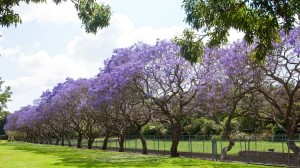
Jacaranda Trees
1. Jacaranda (Jacaranda mimosifolia)
The Jacaranda is a stunning deciduous tree originally from Brazil, but it thrives in many parts of New Zealand’s warmer regions, particularly in the North Island. With its breathtaking display of vibrant purple-blue flowers in late spring and early summer, this tree makes a spectacular addition to any garden.
Jacarandas can grow between 10-15 metres tall and have a wide-spreading canopy that provides excellent shade. However, they do require space to flourish. Their fern-like foliage creates dappled shade, making them a perfect choice for gardens where filtered sunlight is preferred.
Growing Conditions:
- Best suited to warm, frost-free regions (light frosts tolerated but may slow growth)
- Prefers well-draining soil with moderate moisture
- Requires full sun for best flowering
Considerations:
- Avoid planting near swimming pools or gutters, as fallen flowers can clog drains
- Minimal pruning is recommended, as cutting branches can result in vertical water shoots that spoil its natural shape
- Ideal for open lawns or as a feature tree
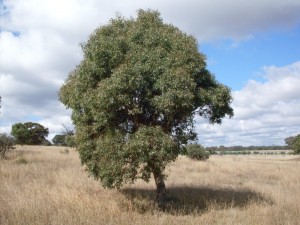
Yellow Box Tree
2. Yellow Box (Eucalyptus melliodora)
Native to Australia, the Yellow Box is an evergreen eucalyptus tree valued for its beautiful form, shade potential, and contribution to biodiversity. This hardy tree is a favourite among beekeepers as it produces high-quality honey. It is well-suited to larger properties and bush-style gardens.
Growing up to 30 metres tall, the Yellow Box provides excellent shade with its broad, rounded canopy. It thrives in a variety of soil conditions, from dry to moist, making it a great option for different regions across New Zealand.
Growing Conditions:
- Suitable for Mediterranean and bush-style gardens
- Grows well in well-draining, sandy, or clay soils
- Thrives in full sun and tolerates drought conditions once established
Considerations:
- Not ideal for small gardens due to its large size
- May drop leaves and bark, requiring some maintenance
- Provides excellent habitat for birds and pollinators
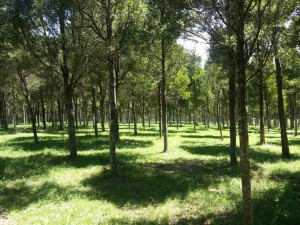
Blackwood Tree Plantation
3. Blackwood (Acacia melanoxylon)
The Blackwood is a fast-growing evergreen tree native to Australia that has adapted well to New Zealand conditions. With its dense foliage and sturdy structure, it offers excellent shade and is also used for erosion control on slopes and riverbanks.
Reaching heights of up to 30 metres, the Blackwood is an ideal choice for those looking for a long-lasting shade tree. It produces small, fragrant yellow flowers in spring and is highly attractive to birds and insects.
Growing Conditions:
- Prefers well-draining soil but adapts to various conditions
- Tolerates coastal exposure and moderate frosts
- Can be grown from seeds or root cuttings
Considerations:
- Can become invasive in some areas if not properly maintained
- Has a strong root system that may disrupt underground pipes and paving
- Can act as a natural fire barrier in rural settings
4. Coast Banksia (Banksia integrifolia)
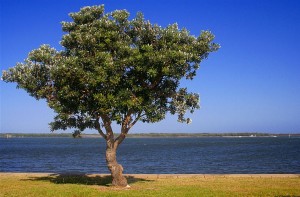
Coast Banksia Tree
A native of Australia’s coastal regions, the Coast Banksia is an evergreen tree with striking pale yellow, upright flower spikes that attract nectar-feeding birds and insects. This tree is highly resistant to salt-laden winds, making it an excellent choice for coastal and exposed gardens.
Growing up to 20 metres tall, the Coast Banksia has a moderately dense canopy that provides filtered shade. It’s a low-maintenance tree, thriving in sandy and clay soils with little need for watering once established.
Growing Conditions:
- Best suited to coastal and exposed areas
- Tolerates a range of soil types, including poor soils
- Thrives in full sun and is drought-resistant once established
Considerations:
- Can be pruned to maintain shape or as a windbreak
- Provides excellent screening and shade
- Moderately frost-tolerant but thrives in warmer climates
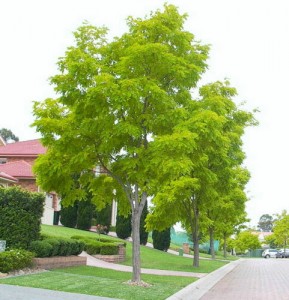
Golden Robinia
5. Golden Robinia (Robinia pseudoacacia ‘Frisia’)
The Golden Robinia is a striking deciduous tree known for its vivid lime-green foliage that turns golden yellow in autumn. In spring, it produces fragrant white flowers that attract bees and other pollinators.
This tree grows rapidly, reaching heights of up to 10 metres, making it ideal for creating quick shade. It is highly adaptable to different soil conditions and is drought-tolerant once established.
Like any grafted plant, take extra care when mowing or gardening around them – particularly Robinias, and use mulch rather than growing grass under grafted trees.
Growing Conditions:
- Thrives in full sun to partial shade
- Tolerates poor and compacted soils
- Moderate drought resistance
Considerations:
- Requires careful maintenance to prevent suckering (new shoots from roots)
- Best to mulch around the base and avoid damaging the roots with lawnmowers or trimmers
- Ideal for open spaces where its brilliant foliage can be fully appreciated
More Trees for Garden Shade
If the previous trees weren’t quite right for your garden, here are five more excellent alternatives to consider:
1. Kānuka (Kunzea ericoides)
A hardy New Zealand native, kānuka is an excellent choice for a shade tree that also supports biodiversity. It grows up to 15 metres tall, with fine, soft foliage that provides light shade while allowing some sunlight through. Kānuka is drought-resistant, attracts native birds and bees, and thrives in various soil conditions, making it a low-maintenance choice for many gardens.
2. Titoki (Alectryon excelsus)
The titoki is an attractive evergreen tree that reaches about 10–15 metres in height. Its lush, glossy leaves create dense shade, and it produces red fruits that attract native birds. It’s well-suited to urban gardens and is tolerant of a variety of soil types, though it prefers well-drained conditions.
3. Liquidambar (Liquidambar styraciflua)
A fantastic option for those who enjoy seasonal colour, the liquidambar is a deciduous tree that provides excellent shade in summer and turns brilliant red, orange, and yellow in autumn. It grows up to 20 metres and prefers well-drained soil. However, its roots can be invasive, so it should be planted away from buildings and paved areas.
4. Tōtara (Podocarpus totara)
A slow-growing but highly durable native tree, tōtara can reach up to 20 metres in height. It has a dense canopy that offers excellent shade and is resistant to wind, making it ideal for exposed areas. While it grows best in fertile, well-drained soil, it can tolerate a wide range of conditions. It can also be pruned and shaped to maintain a smaller size.
5. Chinese Elm (Ulmus parvifolia)
If you’re looking for a fast-growing shade tree with a spreading canopy, the Chinese elm is a great choice. It grows up to 12–15 metres and is drought-tolerant, making it suitable for dry areas. Its smooth, mottled bark gives it year-round appeal, and its small leaves provide dappled shade that is perfect for garden seating areas.
Choosing the Right Tree for Your Garden
Before selecting a tree, consider factors such as where the sun hits your property, the direction your windows face, and the presence of paved areas that may absorb heat. Deciduous trees can be ideal for cooling your home in summer while allowing sunlight in during winter, while evergreens provide consistent shade year-round.
If you need assistance with selecting, planting, or maintaining trees in your garden, Jim’s Mowing can help. Call us on 0800 454 654 or book online for a free, no-obligation quote today!


